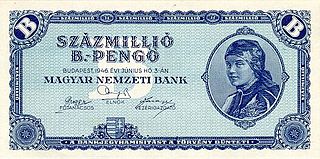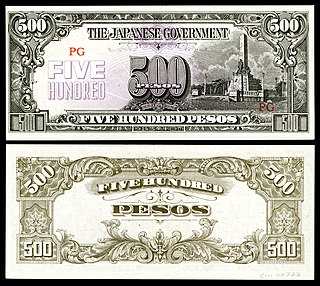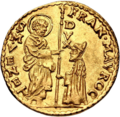
In economics, Hyperinflation is a very high and typically accelerating inflation. It quickly erodes the real value of the local currency, as the prices of all goods increase. This causes people to minimize their holdings in that currency as they usually switch to more stable foreign currencies. When measured in stable foreign currencies, prices typically remain stable. Effective capital controls and currency substitution (“dollarization”) are the orthodox solutions to ending short-term hyperinflation; however there are significant social and economic costs to these policies. Ineffective implementations of these solutions often exacerbate the situation. Many governments choose to attempt to solve structural issues without resorting to those solutions, with the goal of bringing inflation down slowly while minimizing social costs of further economic shocks.

Federal Reserve Notes, also United States banknotes, are the currently issued banknotes of the United States dollar. The United States Bureau of Engraving and Printing produces the notes under the authority of the Federal Reserve Act of 1913 and issues them to the Federal Reserve Banks at the discretion of the Board of Governors of the Federal Reserve System. The Reserve Banks then circulate the notes to their member banks, at which point they become liabilities of the Reserve Banks and obligations of the United States.

A banknote—also called a bill, paper money, or simply a note—is a type of negotiable promissory note, made by a bank or other licensed authority, payable to the bearer on demand. Banknotes were originally issued by commercial banks, which were legally required to redeem the notes for legal tender when presented to the chief cashier of the originating bank. These commercial banknotes only traded at face value in the market served by the issuing bank. Commercial banknotes have primarily been replaced by national banknotes issued by central banks or monetary authorities.

The Bangladeshi taka is the currency of the People's Republic of Bangladesh. In Unicode, it is encoded at U+09F3৳.

The birr is the primary unit of currency in Ethiopia. It is subdivided into 100 santims.

The Reichsmark was the currency of Germany from 1924 until 20 June 1948 in the Trizone, where it was replaced by the Deutsche Mark, and until 23 June 1948 in the Soviet occupation zone of Germany, where it was replaced by the East German mark. The Reichsmark was subdivided into 100 Reichspfennig. The Mark is an ancient Germanic weight measure, traditionally a half pound, later used for several coins; Reich comes from the official name for the German state from 1871 to 1945, Deutsches Reich.
The dong has been the currency of Vietnam since 3 May 1978. It is issued by the State Bank of Vietnam. The dong was also the currency of the predecessor states of North Vietnam and South Vietnam, having replaced the previously used French Indochinese piastre.

The lira was the currency of Italy between 1861 and 2002. It was introduced by the Napoleonic Kingdom of Italy in 1807 at par with the French franc, and was subsequently adopted by the different states that would eventually form the Kingdom of Italy in 1861. It was subdivided into 100 centesimi, which means "hundredths" or "cents". The lira was also the currency of the Albanian Kingdom from 1941 to 1943.

The kyat is the currency of Myanmar (Burma). The typical notation for the kyat is "K" (singular) and "Ks." (plural), placed before the numerals followed by /-.

Counterfeit money is currency produced outside of the legal sanction of a state or government, usually in a deliberate attempt to imitate that currency and so as to deceive its recipient. Producing or using counterfeit money is a form of fraud or forgery, and is illegal. The business of counterfeiting money is nearly as old as money itself: plated copies have been found of Lydian coins, which are thought to be among the first Western coins. Before the introduction of paper money, the most prevalent method of counterfeiting involved mixing base metals with pure gold or silver. Another form of counterfeiting is the production of documents by legitimate printers in response to fraudulent instructions. During World War II, the Nazis forged British pounds and American dollars. Today, some of the finest counterfeit banknotes are called Superdollars because of their high quality and imitation of the real US dollar. There has been significant counterfeiting of Euro banknotes and coins since the launch of the currency in 2002, but considerably less than that of the US dollar.

The lira AOI was a special banknote circulating in Italian East Africa between 1938 and 1941.

The Japanese government-issued dollar was a form of currency issued for use within the Imperial Japan-occupied territories of Singapore, Malaya, North Borneo, Sarawak and Brunei between 1942 and 1945. The currency was also referred to informally as banana money, named as such because of the motifs of banana trees on 10 dollar banknotes. The Japanese dollar was in widespread use within the occupied territories where the previous currency became scarce. The currency were referred to as "dollars" and "cents" like its predecessors, the Straits dollar, Malayan dollar, Sarawak dollar and British North Borneo dollar.

During World War II in the Philippines, the occupying Japanese government issued a fiat currency in several denominations; this is known as the Japanese government-issued Philippine peso. The Japanese government outlawed possession of guerrilla currency, and declared a monopoly on the issuance of money, so that anyone found to possess guerrilla notes could be arrested or even executed.
This page is a glossary of notaphily. Notaphily is the study of paper money or banknotes.

Japanese invasion money, officially known as Southern Development Bank Notes, was currency issued by the Japanese Military Authority, as a replacement for local currency after the conquest of colonies and other states in World War II.
The 1 yen note (1円券) was a denomination of Japanese yen in seven different series from 1872 to 1946 for use in commerce. These circulated with the 1 yen coin until 1914, and briefly again before the notes were suspended in 1958. Notes from the Japanese government, known as "government notes," were the first to be issued through a company in Germany. Because they were being counterfeited, they were replaced by a new series which included the first portrait on a Japanese banknote. Almost concurrently, the government established a series of national banks modeled after the system in the United States. These national banks were private entities that also released their own notes which were later convertible into gold and silver. All three of these series came to an end due to massive inflation from the Satsuma Rebellion in 1877. National bank notes were re-issued as fiat currency before the national banks themselves were abolished. Both national bank and government one yen notes were gradually redeemed for Bank of Japan note starting in 1885. This redemption process lasted until all three series were abolished in 1899.

Italy has a long history of different coinage types, which spans thousands of years. Italy has been influential at a coinage point of view: the medieval Florentine florin, one of the most used coinage types in European history and one of the most important coins in Western history, was struck in Florence in the 13th century, while the Venetian sequin, minted from 1284 to 1797, was the most prestigious gold coin in circulation in the commercial centers of the Mediterranean Sea.
Allied Military Currency ("AMC") was a form of currency issued by the Allied powers during World War II, to be issued to troops entering liberated or newly occupied countries, as a form of currency control.
The 2 yen note (2円券) was a denomination of Japanese yen issued in two different overlapping series from 1872 to 1880 for use in commerce. Meiji Tsūhō "two yen" notes were the first to be released as inconvertible government notes in 1872. These notes were produced both domestically, and in Germany using western technology. While they had an elaborate design, the notes eventually suffered in paper quality, and were counterfeited. Two yen Meiji Tsūhō notes were not redesigned with other denominations in response to these issues. The series as a whole was effected by massive inflation that occurred during the aftermath of the Satsuma Rebellion in 1877. Too many non convertible notes had been issued to pay for the expenses incurred. Government notes stopped being issued in 1879, and the Bank of Japan was established in 1882 as a way to redeem old notes for new ones issued by the bank. This redemption period expired when the notes were abolished on December 9, 1899.
Meiji Tsūhō (明治通宝) refers to the first paper currency that was issued by the Imperial Japanese government during the early Meiji era. After the "yen" was officially adopted in 1871, the Japanese looked to the Western World for their improved paper currency technology. An agreement was made with Italian engraver Edoardo Chiossone, who designed 6 denominations of Yen, and 3 denominations of Sen. The Japanese Government's decision to issue these notes as fiat currency ended in disaster as inflation rose following the Satsuma Rebellion. Meiji Tsūhō notes were ultimately demonetized towards the end of the 19th century.















